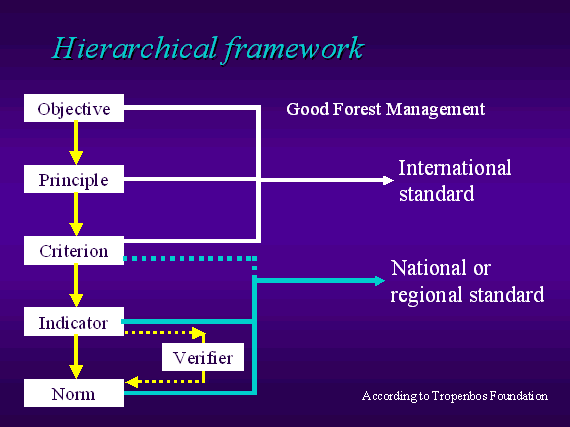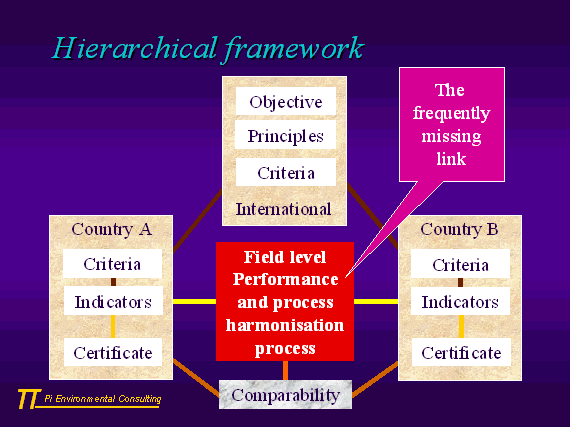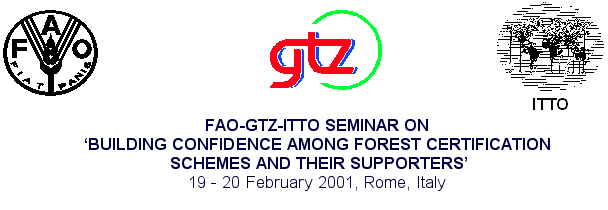Some key elements of forest certification
Presentation prepared for the FAO / GTZ / ITTO seminar "Building Confidence..."
Rome 19 & 20 February
2001
Pierre Hauselmann
|
Two definitions
Certification scheme
Certification system
|
Objective
· Review some key elements of forest
certification
· Possible input into the discussions - no
conclusion |
Elements
· Components of forest certification
· Approaches (system /
performance)
· Relation
between governmental C&I processes and certification
· Hierarchical framework for the
elaboration of a forest certification standard
· An implication of mutual recognition |
Components of forest certification
What is usually understood under "forest certification" is
the addition of several activities, which have all their own rules and
guides:
·
Certification
· Standardisation
· Accreditation
· Logo use (labelling)
> Any mechanism for MR should clearly make the
distinction |
Approaches
System and performance
approaches
System
ASSUMTION: if a good system is
operating, it will lead to satisfactory performance
|
System and performance
approaches
Performance
· Objectives (performance) are set outside the
organisation, and must be met to be awarded a certificate
· So that, it is possible to claim credibly that a
sufficient level of performance has been reached
ASSUMPTION: If the
environmental performances are good, a satisfactory system is in
place
|
System and performance
approaches
BOTH HAVE A ROLE TO PLAY!!!
System: helps reach performances
Performance: ensures that the
performances
are achieved on
the ground and claims about it |
Claims - system
· A management system is in place
· "...two organizations carrying out similar
activities but having different environmental performances may both
comply with... [the] requirements [of
this standard]." (ISO 14001 - introduction)
· If certification is granted on the basis of a quality
system, the "logo shall not be used on a product or in a way
that may be interpreted as denoting product conformity" (ISO/IEC
Guide 62 - 3.7.2)
· "No link found between management systems
and performance" (Bate's ISO 14000 update - January 2001)
· No claim of performance |
Claims - performance
· That a performance has been
reached
· "Environmental labels and declarations shall be
accurate, verifiable, relevant and not misleading." (ISO
14020 - principle 1)
· "At this time there are no definitive methods for
measuring sustainability or confirming its accomplishment. therefore,
no claim of sustainability shall be made." (ISO 14021 -
5.5) |
Distinguishing system &
performance
· Sometimes easy:
|
Distinguishing system &
performance
· Sometimes difficult:
|
Relation between governmental C&I processes and certification
WTO TDT
World Trade Organization's Technical Barrier to Trade
agreement
· "Standard: document approved by a recognised
body that provides, for repeated use, rules, guidelines or
characteristics for product or related processes and
production methods, with which compliance is not
mandatory..." (TBT - Annex 1 - Terms and their definitions for
the purpose of the Agreement)
· "where international standards exist or
their completion is imminent, the [national] standardizing body
shall use them, or the relevant parts of them, as a basis for
the standards it develops..." (TBT Annex III - code of good
practice for the Preparation, Adoption and Application of Standards -
Substantive Provision F). |
WTO TBT
· "International body or system: body
or system whose membership is open to the relevant bodies of at least
all members" (TBT annex 1)
· "Regional body or system: body or
system whose membership is open to the relevant bodies of only some
members" (TBT annex 1)
ISO/IEC Guide 2 definitions apply if not mentioned otherwise
in TBT annex 1 |
ISO/IEC Guide 2
· "International standard: standard
that is adopted by an international standardizing/standards
organization and made available to the public"
· "International standardization:
standardization in which involvement is open to relevant bodies from
all countries" |
Forest certification
"documents"
· Are they standards?
|
Governmental C&I
processes
· Are they International or regional
standards?
· Governmental C&Is cannot be
considered as international standards to be used by national
standardisation bodies to develop national standards
|
Hierarchical framework for the elaboration of a forest certification
standard

|
Hierarchical framework
· Highlights the fact that forest certification standards
have both globally and locally applicable elements
· Helps streamline the development of national/regional
standards
· Ensure that "standardizing body ... uses them
[international standards], or the relevant parts of them, as a
basis for the standards it develops" (TBT code of good
practice...) |
Hierarchical framework

|
An implication of mutual recognition |
|
Bodies in a MR agreement recognise the weaknesses
of the others as sufficiently requiring to satisfy their own
requirements
|



